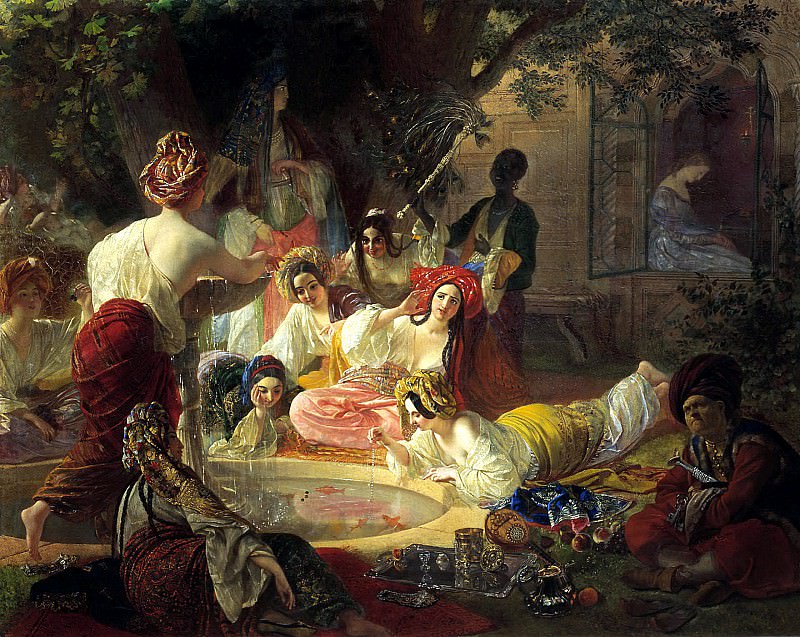BRYULLOV Karl – Bakhchisarayskiy Fountain 900 Classic russian paintings
BRYULLOV Karl - Bakhchisarayskiy Fountain
Edit attribution
Download full size: 1760×1400 px (1,0 Mb)
Back to album: 900 Classic russian paintings
The great Russian artist Karl Bryullov was a great admirer of Pushkin’s genius. Mourning the poet’s death, the artist regretted not being able to depict him during his lifetime. Having visited the Crimea many times, Bryullov chose the famous "Fountain of Bakhchisarai" as his own monument to the departed genius. Work on the painting, which began a few years after the death of Pushkin, was conducted for a very long time - nearly eleven years.
Description of the painting "The Fountain of Bakhchisarai" by Karl Bryullov
The great Russian artist Karl Bryullov was a great admirer of Pushkin’s genius. Mourning the poet’s death, the artist regretted not being able to depict him during his lifetime. Having visited the Crimea many times, Bryullov chose the famous "Fountain of Bakhchisarai" as his own monument to the departed genius. Work on the painting, which began a few years after the death of Pushkin, was conducted for a very long time - nearly eleven years. There are many sketches and sketches for "The Fountain of Bakhchisarai" in the diaries and albums Bryullov. In 1849 "The Fountain of Bakhchisarai" was purchased by Grand Duchess Maria Nikolayevna. Now the watercolor canvas is kept in the Pushkin Museum in Moscow.
The fountain itself on the territory of the Khan’s palace in Bakhchisarai had long since become covered with legends and tales. It was built near the mausoleum of one of the concubines of khan Kyrym-Gerei.
There is practically no fountain in the picture. Virtually abandoning the theme of opposing khan’s wives, praised by Pushkin, the artist depicts women enjoying life - they luxuriously recline in the shade of a tree, enjoying sweet fruit. The gorgeous silk garments emphasize the carefree, serene existence of the concubines. A reminder of their unwilling confinement here are the guards, silent, standing in the corners. However, they only guard the fun, the concubines pay no attention to them, they are engrossed in the amusements and pleasures of life. Bryullov masterfully depicted the serene, romantic life of oriental beauties.
Кому понравилось
Пожалуйста, подождите
На эту операцию может потребоваться несколько секунд.
Информация появится в новом окне,
если открытие новых окон не запрещено в настройках вашего браузера.
You need to login
Для работы с коллекциями – пожалуйста, войдите в аккаунт (open in new window).




















COMMENTS: 2 Ответы
Переверните, пожалуйста, "Бахчисарайский фонтан". Он у вас в зеркальном положении.
Ольга А., спасибо, информация подтвердилась, ошибка исправлена
You cannot comment Why?
The women are portrayed in various states of repose and engagement, some interacting with the fountain, others with each other, and some lost in their own thoughts. Their expressions range from playful to contemplative, hinting at the diverse lives and emotions within this seemingly idyllic setting. The artist has paid meticulous attention to detail in their attire, jewelry, and hairstyles, creating a rich tapestry of textures and colors.
In the background, a darker-skinned attendant stands, holding a large fan and looking out towards the viewer, adding an element of exoticism and perhaps surveillance. To the right, a lattice-covered window offers a glimpse into an interior space where a lone woman in blue, with her head bowed, sits in what could be an expression of melancholy or quiet contemplation. This contrast between the lively group by the fountain and the solitary figure in the window adds depth and a subtle narrative tension to the painting.
The subtexts of the painting likely revolve around themes of beauty, sensuality, leisure, and perhaps the underlying confinement or emotional complexities of life within such a secluded and controlled environment. The luxuriant setting and the beauty of the women convey a sense of earthly pleasure and indulgence. However, the presence of the attendant and the solitary figure in the window can be interpreted as symbols of power dynamics, servitude, and the potential for unfulfilled desires or sorrow that might exist beneath the surface of this opulent scene. The title itself, referencing Bakhchisaray (the former capital of the Crimean Khanate), evokes a sense of exoticism and historical orientalism, a common artistic interest during Bryullovs time.